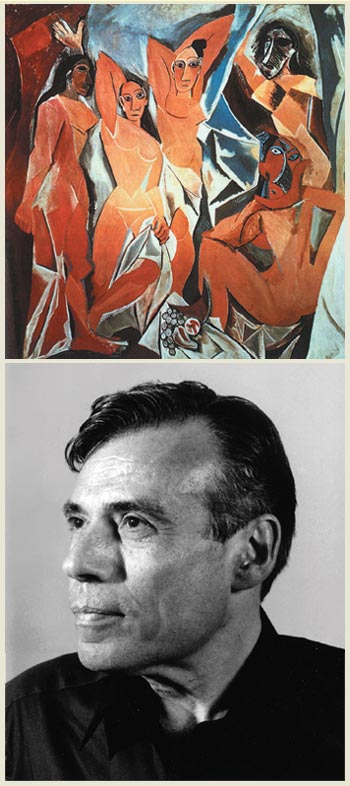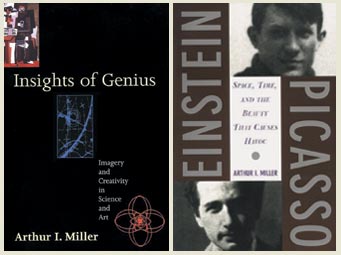Was it a coincidence that Picasso developed Cubism at about the same time that Einstein published his theory of relativity? Arthur I Miller thinks not, as he explains to Ciara Muldoon

On the wall of Arthur I Miller’s office at University College London is a graph drawn by Charles Joseph Minard that illustrates Napoleon’s advance into Russia in 1812. Starting at the Polish-Russian border, the graph shows the losses suffered by Napoleon’s army as it marched towards Moscow, and then retreated in the bitterly cold winter. It captures, Miller estimates, six or seven “dimensions” – time, space and temperature among others – on a 2D surface. The graph also illustrates Miller’s own interests in the interactions between physics and art, the visual representation of ideas and, one might even argue, his own journey from mainstream physics to the interface between science, history and art.
Particle theory and beyond
A physics graduate of the City College of New York, Miller gained his PhD from the Massachusetts Institute of Technology and started his career in particle theory. After further research at the University of Massachusetts, he moved to Harvard, where he switched disciplines to study the history and philosophy of science. “It was unknown territory for me at the time,” he recalls. “I wasn’t even aware that the field existed.”
So why did be change track? “I was always interested in why things happen,” he says, “so I thought I’d look into it.” As a historian and philosopher of science, Miller studied the works of Einstein, Poincaré, Bohr and Heisenberg, and published and edited books on the history of relativity and quantum theory. A major breakthrough came in Paris in 1976 when he discovered Poincaré’s letters and manuscripts in the possession of Poincaré’s grandson. The papers, which had been missing since the great French mathematician’s death in 1912, showed how his research interests reflected his philosophical views.
Miller has since moved away from conventional history of science, having become interested in visual imagery through reading the German-language papers of Einstein, Heisenberg and Schrödinger – “people who were concerned with visualization and visualizability”. Philosophy was an integral part of the German school system in the early 1900s, Miller explains, and German school pupils were thoroughly trained in the philosophy of Immanuel Kant.
According to Kant, visualizations are abstractions of phenomena that we have actually witnessed, while visualizability refers to the properties of an object that exist whether or not we look at it or take measurements of it. In Newtonian physics, visualization and visualizability are synonymous, but in quantum mechanics they are not.
Einstein and Schrödinger never fully accepted the highly abstract nature of Heisenberg’s quantum mechanics, says Miller. They agreed with Galileo’s assertion that “the book of nature is written in mathematics”, but they also realized the power of using visual imagery to represent mathematical symbols.
Heisenberg, however, went further than this, and his subsequent research laid the groundwork for Feynman diagrams – visual representations that marry intuition and imagery. Here the visual imagery is generated by the mathematics of quantum mechanics, rather than being abstracted from phenomena that we have actually seen.
Einstein and Picasso
It was Miller’s research into visual imagery in physics that led him into the world of art. The thread running through his 1996 book Insights of Genius: Imagery and Creativity in Science and Art is that the human mind is the ultimate instrument in both art and science (Physics World August 1997 p51). The book explores the interrelations between intuition, aesthetics, visual imagery and representation, as scientists and artists attempt to “read” nature.
In his most recent book, Einstein, Picasso: Space, Time and the Beauty That Causes Havoc (2001 Basic Books), Miller argues that Poincaré is the link between relativity and Cubism. Both Einstein and Picasso, he claims, were influenced by Poincaré’s non-Euclidean approach to geometry and his speculations on simultaneity – Einstein directly through reading a German translation of Poincaré’s La Science et l’hypothèse,. and Picasso indirectly through a circle of friends and acquaintances known as “la bande à Picasso”. Miller’s argument is that Einstein and Picasso were both working on the same problem, the nature of simultaneity – temporal simultaneity for Einstein and spatial simultaneity for Picasso – and that for both of them there were no preferred reference frames in which to view phenomena.
Many historians of art have felt that relativity somehow influenced the development of Cubism, but they have never believed that there was a direct link between the two. What prompted Miller to delve into the topic in such detail? “I always had an interest in art, and Picasso particularly, and Cubism even more particularly,” he says. “It seemed to me that there was more science in there than met the eye and had been investigated before. The roots of science are not even in science,” he continues, “so why should the roots of Cubism be just in art? Maybe it is, but I really doubt it. There’s too much science in what Picasso was doing.”
Miller regards Cubism as a “research programme” in which Picasso, like Einstein, discovered a new aesthetic – the reduction of forms to geometrical representations. This involved simultaneously representing, on a single canvas, many different viewpoints. “That had to have something to do with science,” says Miller, “so I looked into it in great detail. I reviewed all the newspapers Picasso had read and looked back into what was going on at that time in literature as well.” Although Einstein and Picasso were unaware of each other, the avant-garde movement in the first decade of the 20th century encouraged them both to question the traditional understanding of space and time.
The question of whether Picasso was fluent in French has been much debated in art circles. Many argue that he could barely read a newspaper, let alone study Poincaré’s book, but Miller believes that there may have been more direct links. “What I did was to get the sources that were written as close as possible to 1907, when Picasso painted Les Demoiselles d’Avignon, and put together a story where mathematics really did matter,” he says.
Miller discovered someone in Picasso’s circle – an insurance actuary called Maurice Princet – who studied advanced mathematics as a hobby. Princet had read and lectured on Poincaré to Picasso and his friends. “Princet was in Picasso’s atelier at the time that Picasso was having a great deal of trouble with Demoiselles,” he explains. “My hypothesis is that just at that point, Picasso realized the importance of what Princet was discussing concerning geometry.” However, Miller is careful to point out that we will never know for sure how much Picasso was influenced by the work of Poincaré.
Miller’s book has, on the whole, been well received. Writing in the Irish Times, the novelist John Banville called it “learned, inspired and daring… a fine and stimulating book that makes breath-taking connections across the gap between the so-called two cultures of science and art”. The New York Times Book Review said that Miller had written a “double detective story [and] an intellectual thriller” in which he manages to “quantum tunnel into art history from the history of science, appearing suddenly on the other side of the barriers without showing the usual signs of strain”.
Back to basics
Miller is currently writing a book about black holes. There are lots of “gee whiz” books on black holes, he says, but the intense struggles that took place between Eddington and Chandrasekhar in the 1930s, concerning the collapse of stars, have never been analysed in depth. “There was also a fear of things disappearing, and many people, including Einstein, didn’t understand the mathematics,” says Miller. “So until the 1960s black holes were considered theoretical monstrosities that couldn’t actually exist – an ugly solution to the most beautiful theory ever created.”
“Today,” Miller continues, “black holes have taken their place in the fabric of nature and have become symbols of its frightening beauty.” In addition to covering the physics and mathematics of black holes in a way that can be understood by non-specialists, the book will, he says, address the differences in outlook of astrophysicists and physicists, other cultural conflicts and the Cold War. “The whole episode”, says Miller, “sheds light on what science is, how it works and where it can go wrong.”
Back in the present, Miller says that computers are having an immense impact on scientific creativity. “This is the real rapprochement between art and science,” he says. “Progress has been impeded by primitive computer architectures, but it will be amazing when it really gets going.”




